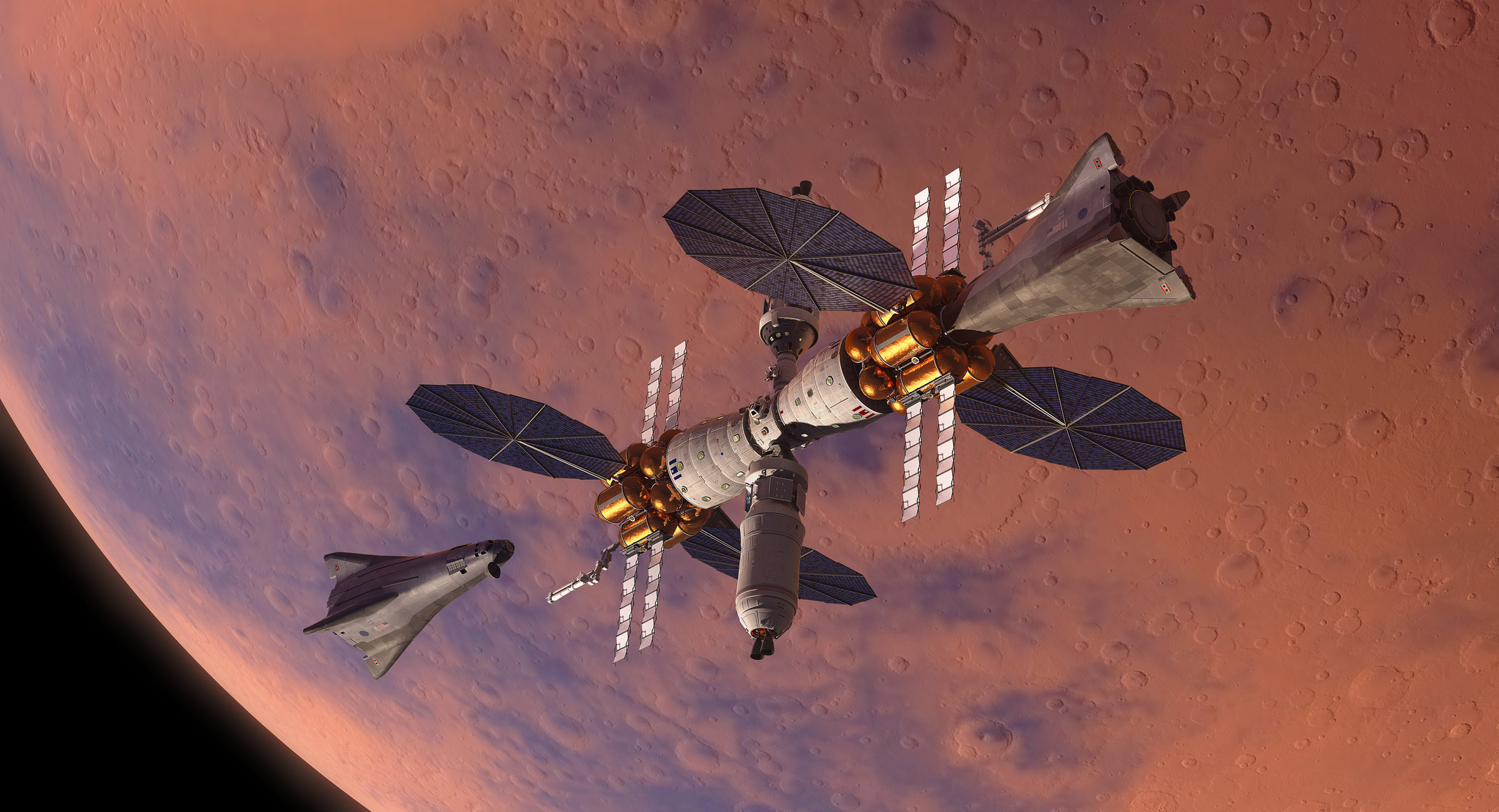
Speaking at the International Astronautical Congress (IAC) in Adelaide, Australia, officials with Lockheed Martin today revealed their vision for what they believe is a sound, safe and compelling mission architecture to help NASA get humans to Mars within a decade, using a concept centered around an orbiting outpost they call the Mars Base Camp.
“Sending humans to Mars has always been a part of science fiction, but today we have the capability to make it a reality,” said Lisa Callahan, vice president and general manager of Commercial Civil Space at Lockheed Martin. “Partnered with NASA, our vision leverages hardware currently in development and production. We’re proud to have Orion powered-on and completing testing in preparation for its Exploration Mission-1 flight and eventually its journey to Mars.”
Plans for building the outpost align with NASA’s Space Launch System SLS rocket, Orion spacecraft and the agency’s plans for a Deep Space Gateway orbiting the moon, which will serve as a critical staging point for missions to the lunar surface and deeper into space, such as to asteroids and Mars in the 2030s.
The first launch of an SLS and Orion, Exploration Mission 1 (EM-1), which will be a shakedown flight to the moon and back of the integrated SLS/Orion system, won’t launch until 2019, with the first crewed Orion mission to lunar orbit occurring around 2-3 years later.
Such a lunar outpost will offer a true deep space environment for astronauts to gain experience and have opportunity to build and test the systems needed for the very challenging missions that will follow, but will also offer the ability for crews to return to Earth if needed in days – rather than weeks or months on missions further into space (such as Mars).
Lockheed is already developing a prototype habitat for the gateway under a contract with NASA, taking the old Donatello Multi-Purpose Logistics Module (MPLM) once used in the payload bay of the space shuttles to transfer cargo to the ISS, and refurbishing it to prototype their deep space habitat in the Space Station Processing Facility at Kennedy Space Center in Florida.
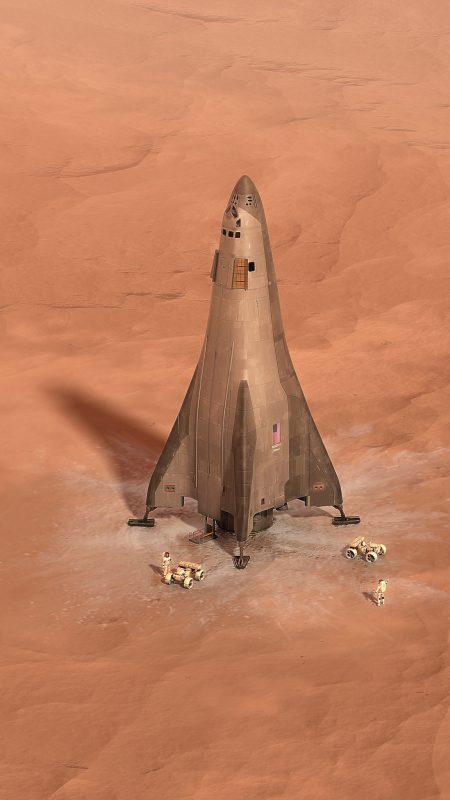
And although some components of the Mars Base Camp’s architecture will be pre-positioned in Mars orbit ahead of time, the Mars Base Camp would ultimately be built up at the Deep Space Gateway, away from Earth’s gravity, before being deployed to the Red Planet.
An Orion spacecraft would serve as the heart of the outpost, same as the Deep Space Gateway.
In addition to an orbiting base camp, Lockheed also envisions a reusable, single-stage lander for the outpost called a Mars Accent Descent Vehicle (MADV), using Orion avionics and systems as its command deck and powered by engines using liquid-hydrogen/liquid-oxygen propellant, both of which will be generated from water.
The lander would be capable of conducting surface mission as long as two weeks in length, with up to four astronauts, before returning to the orbiting outpost where it would be refueled and readied for another mission.
Some more images of the Mars Base Camp concept from Lockheed below.
.
.
FOLLOW AmericaSpace on Facebook!
.
Missions » SLS »



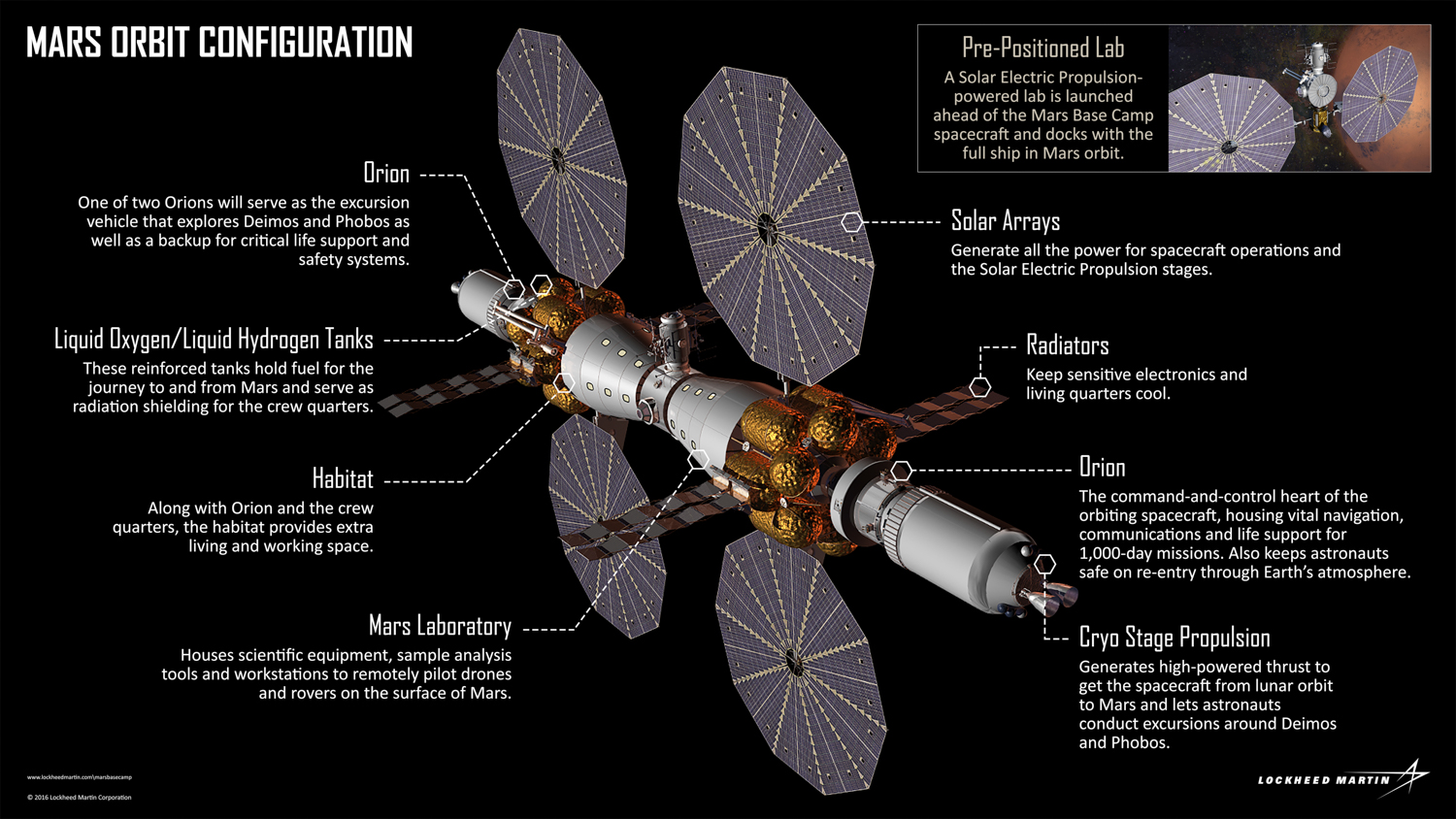
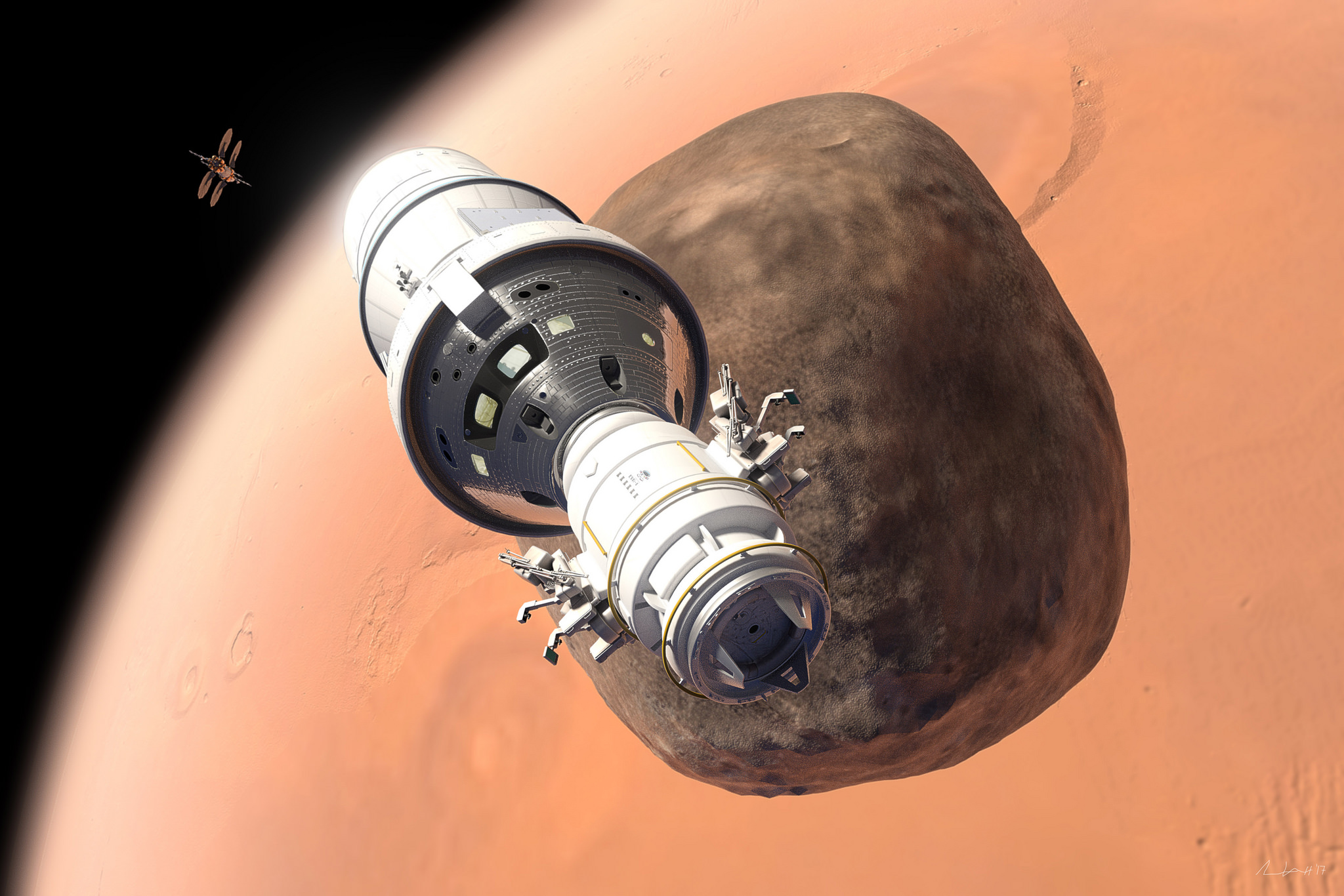
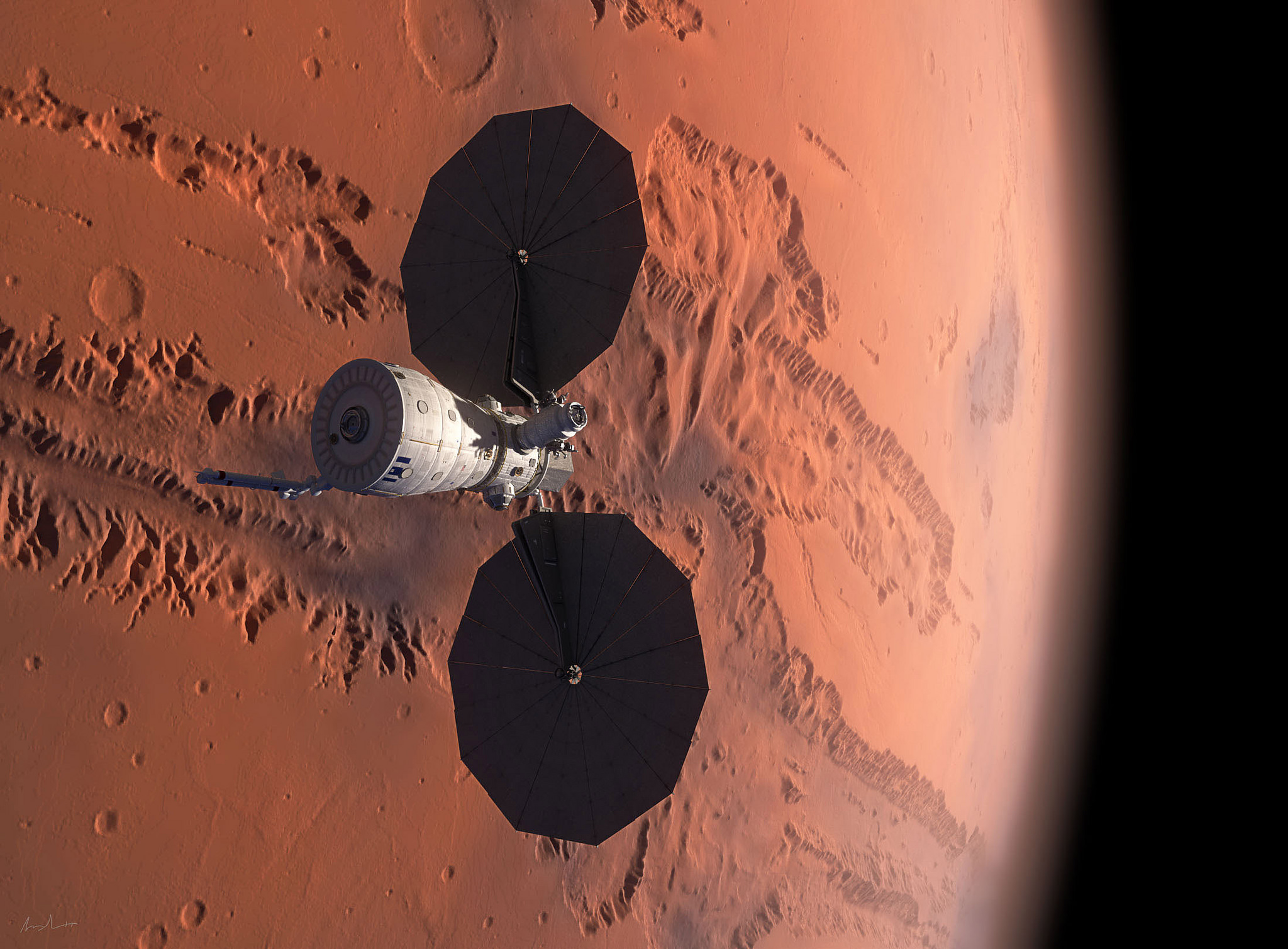
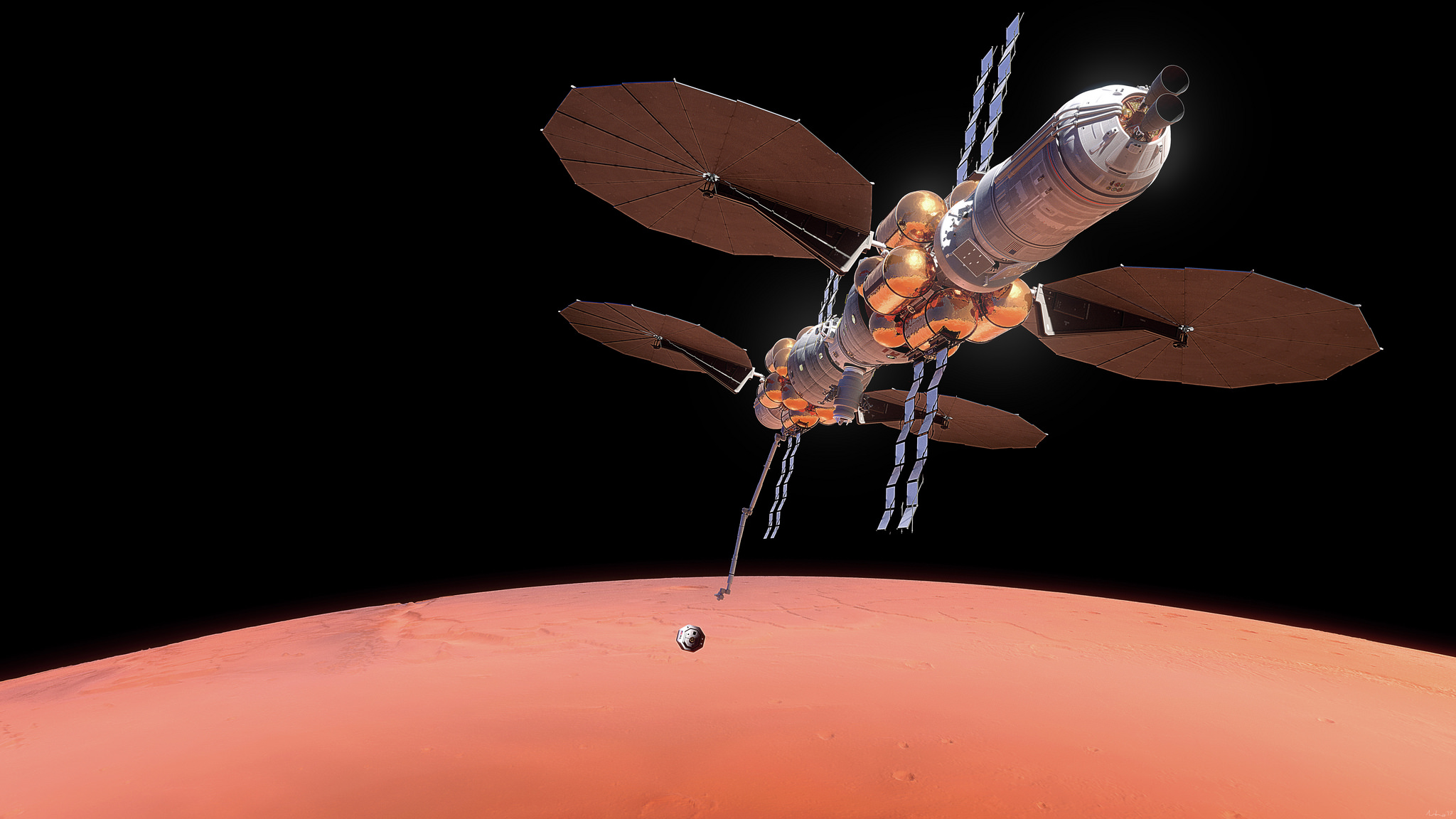
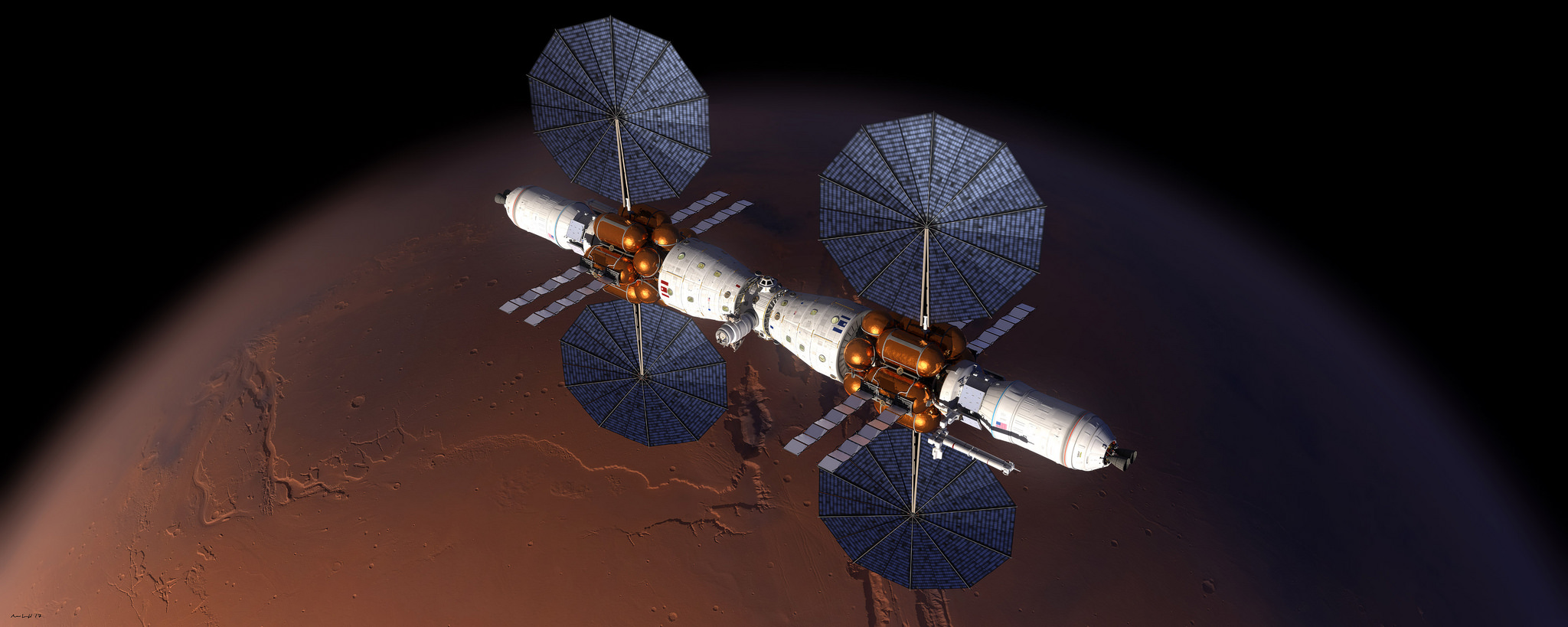
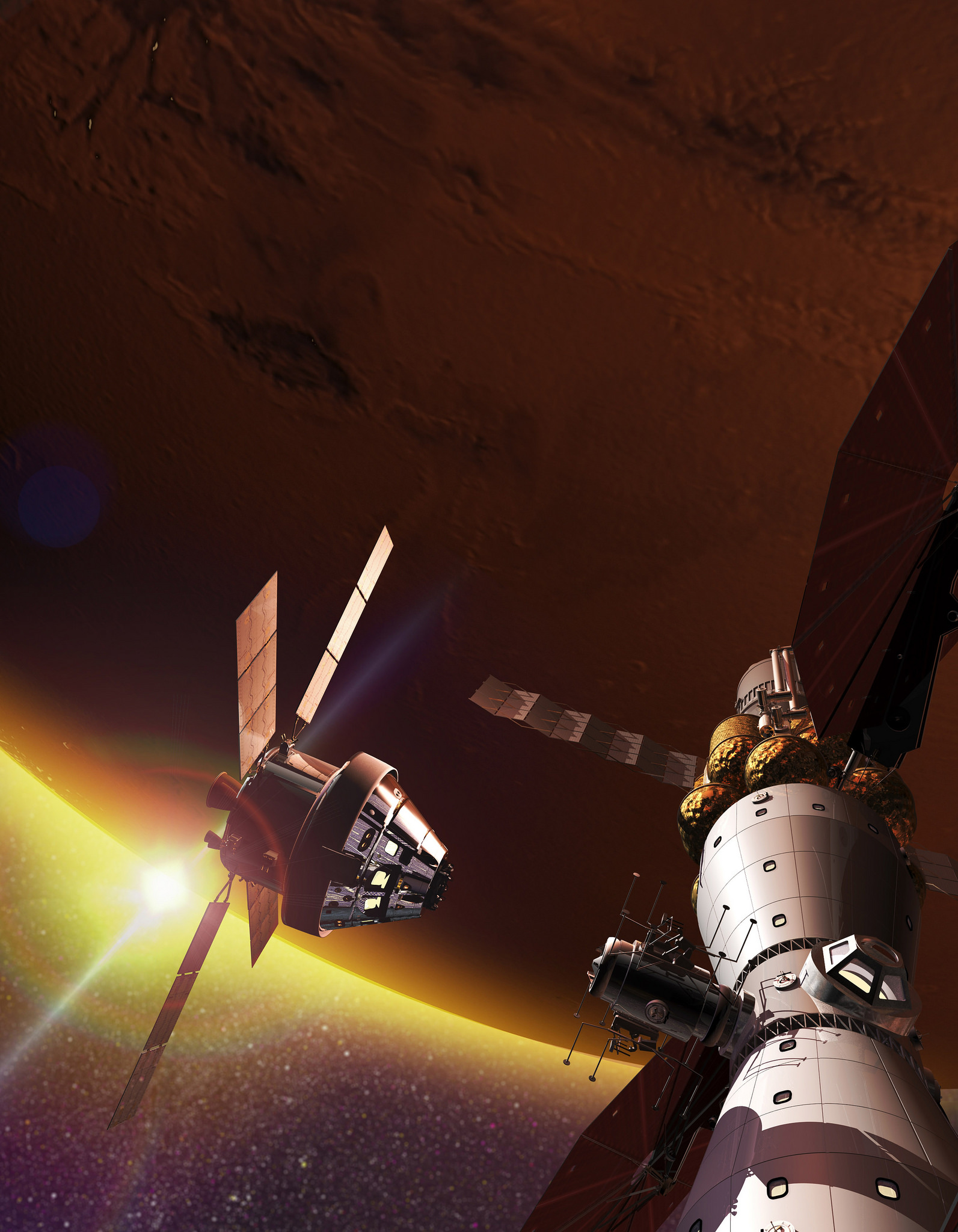
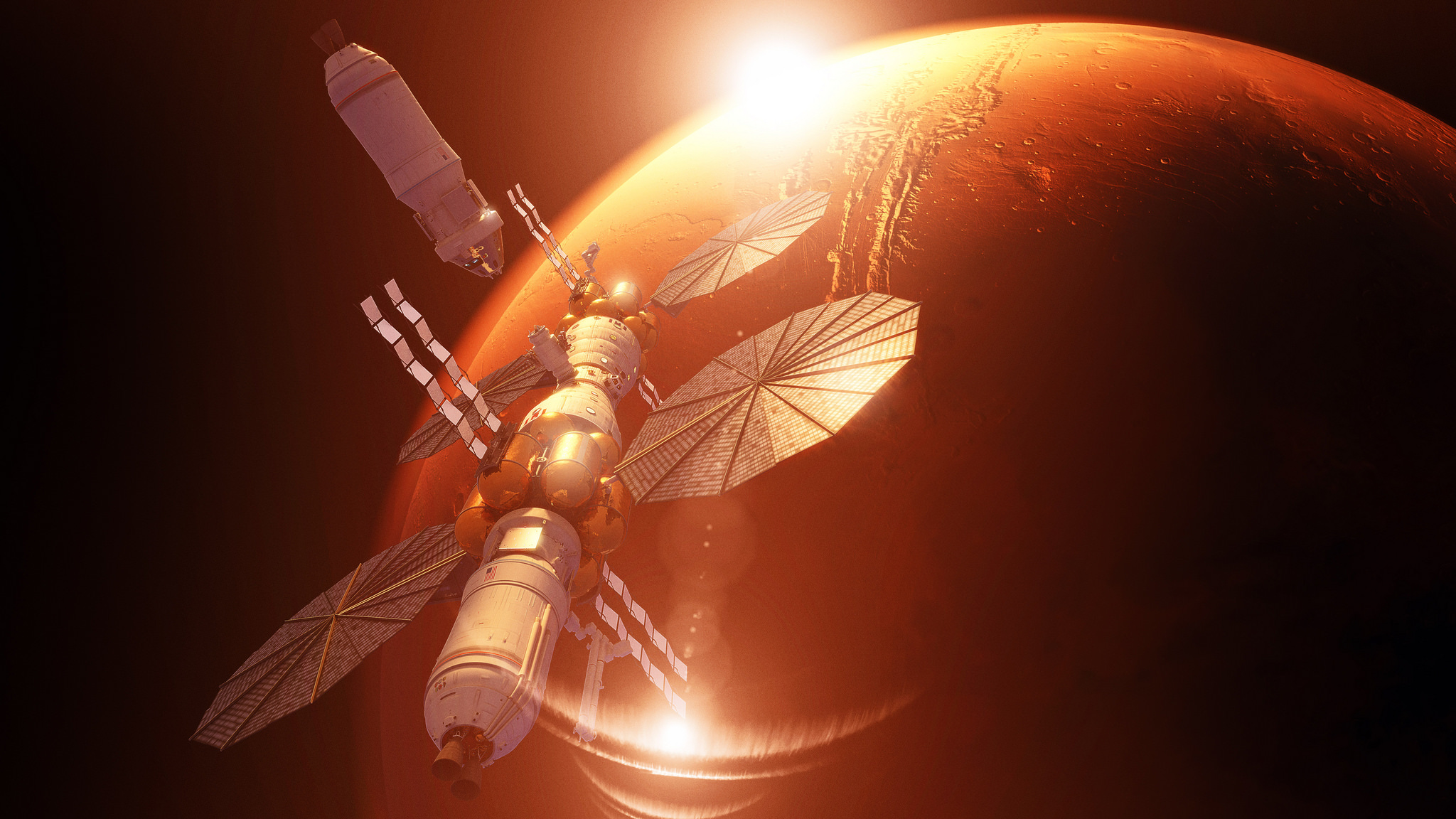
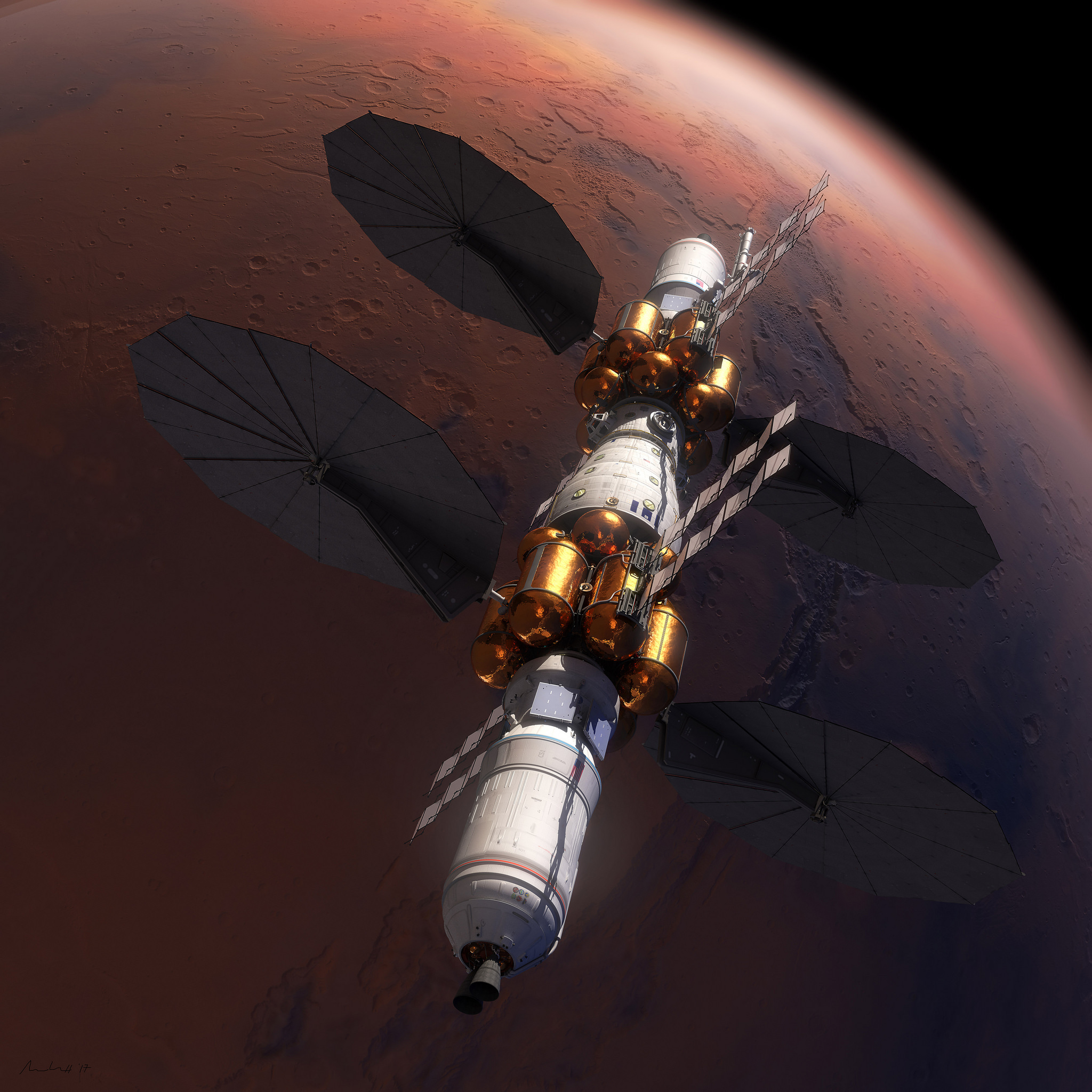
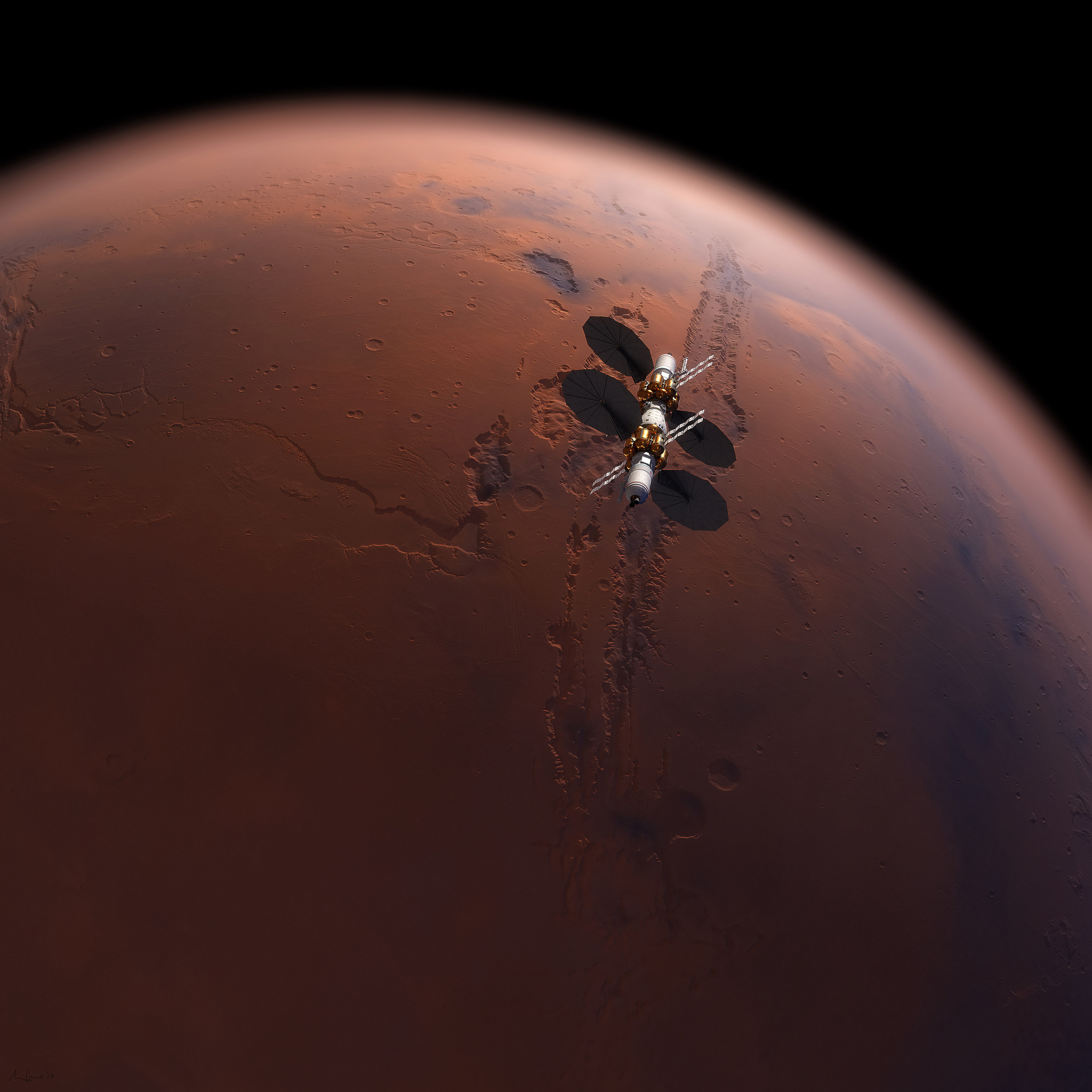
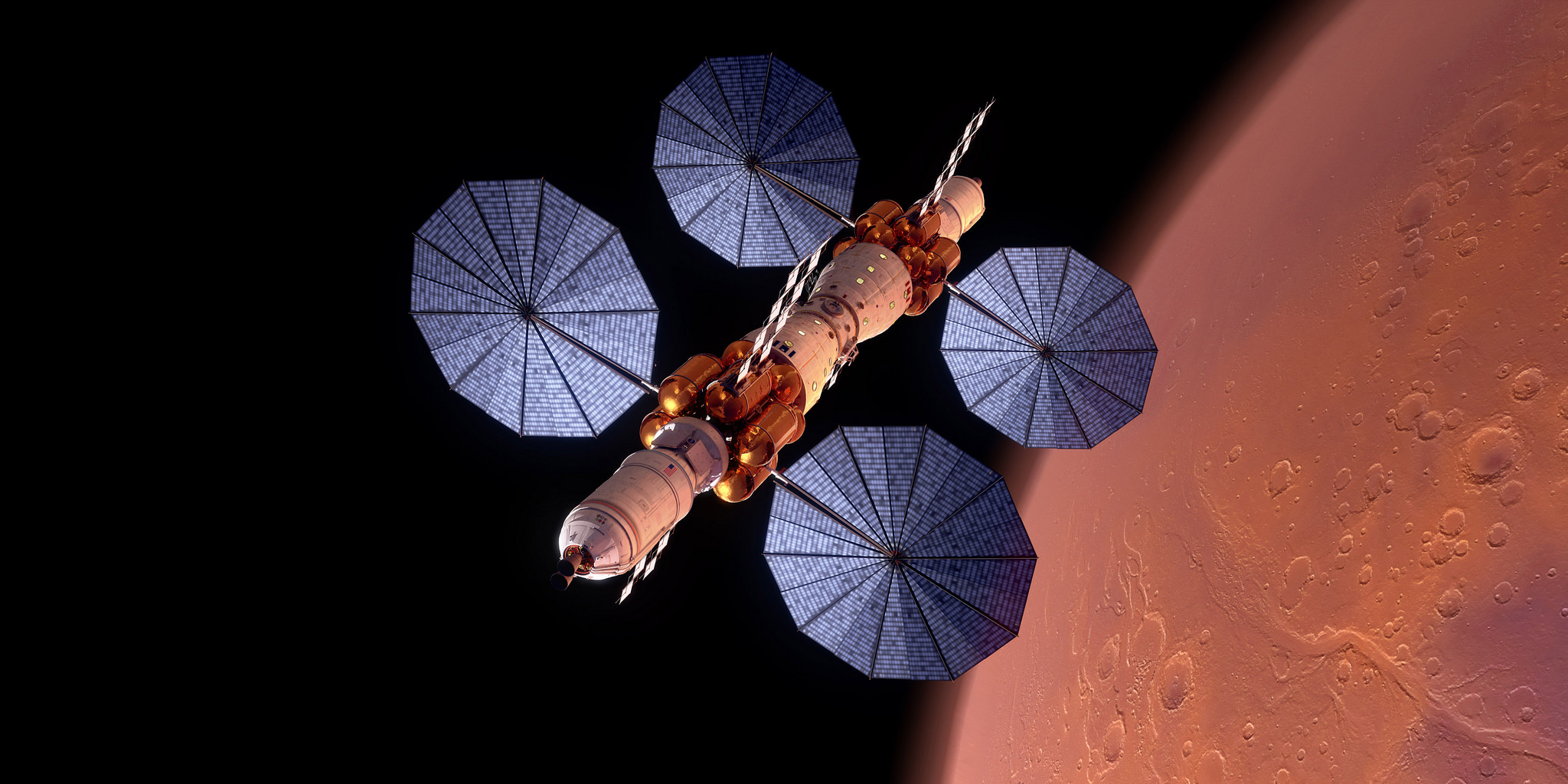
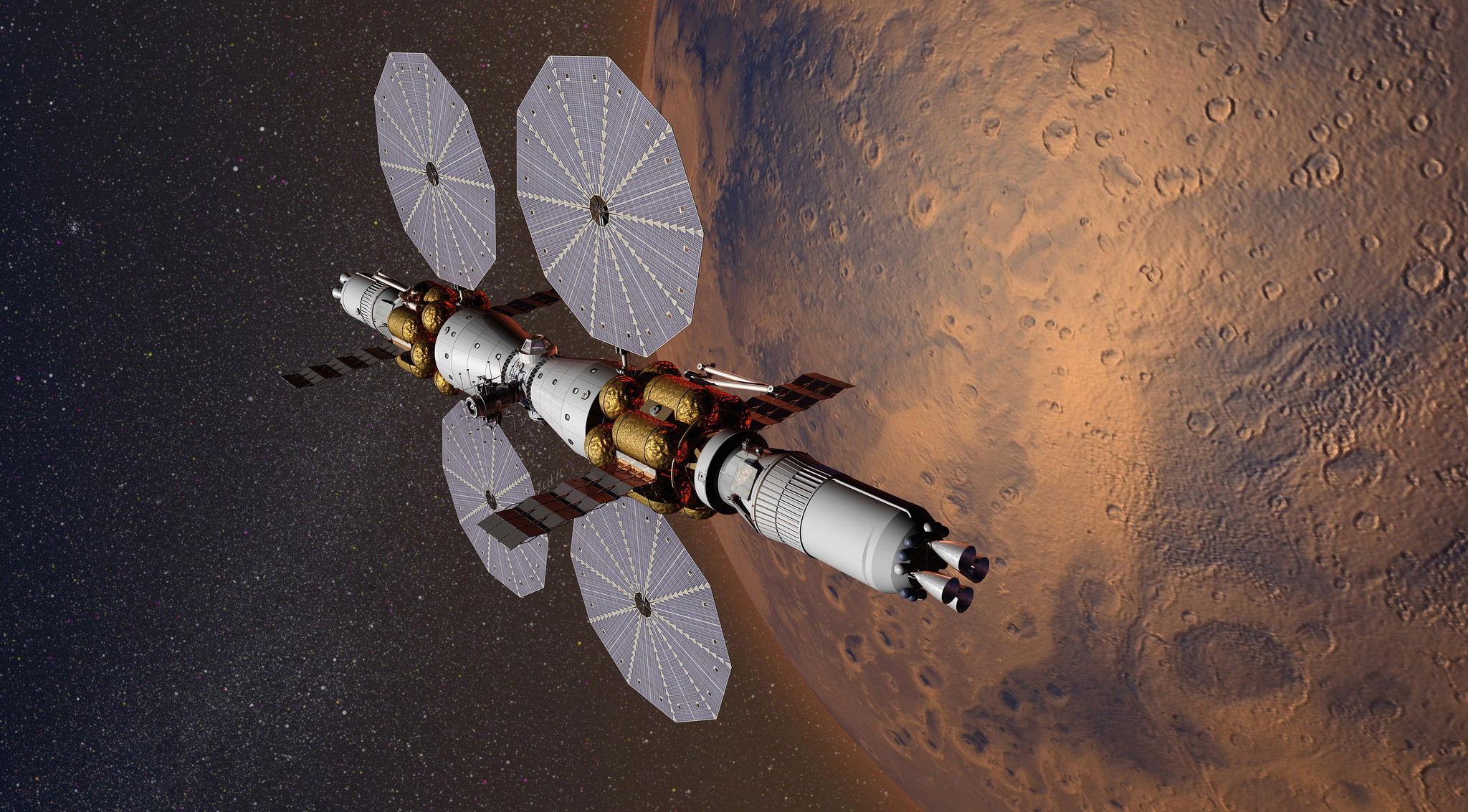
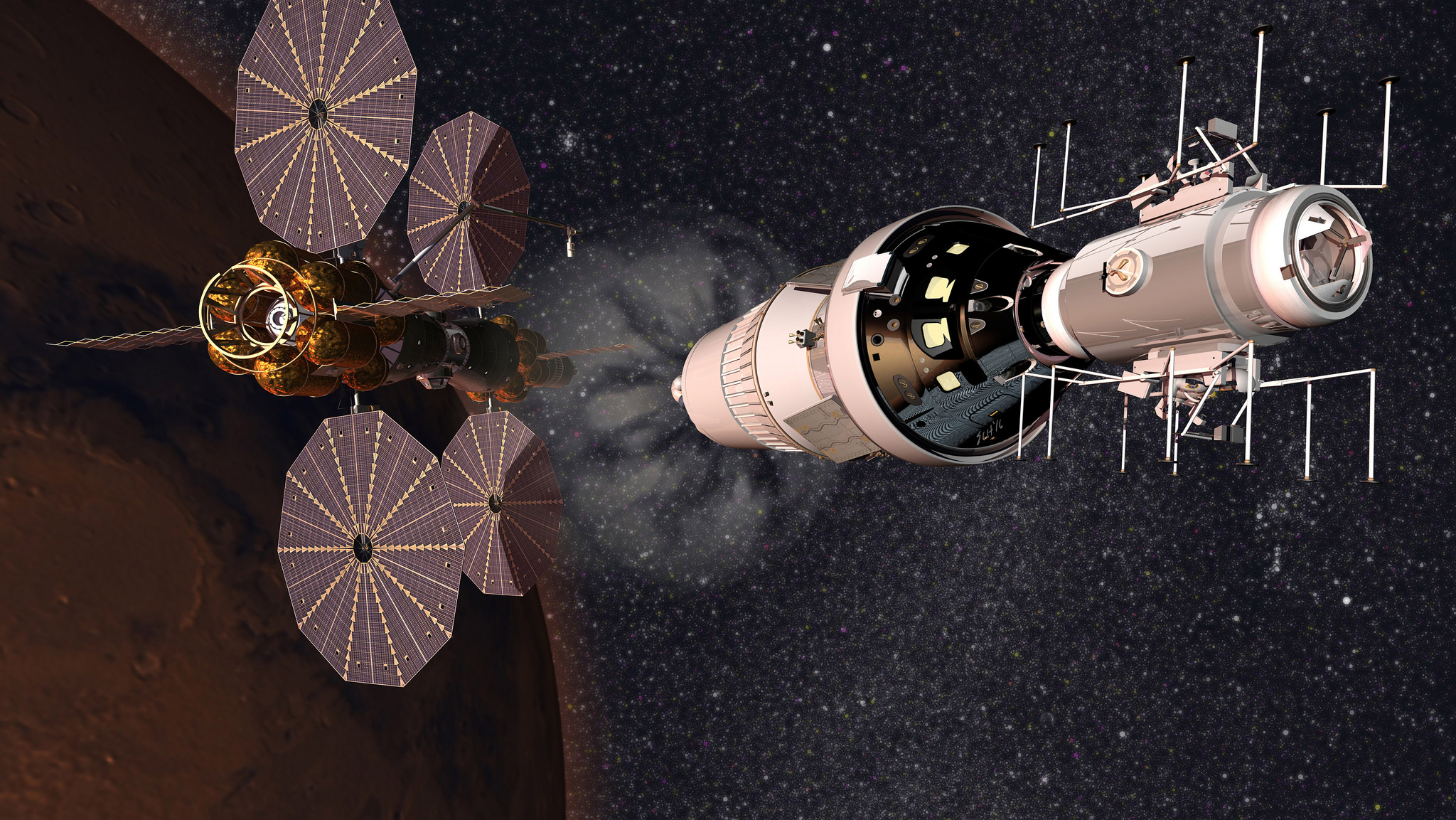
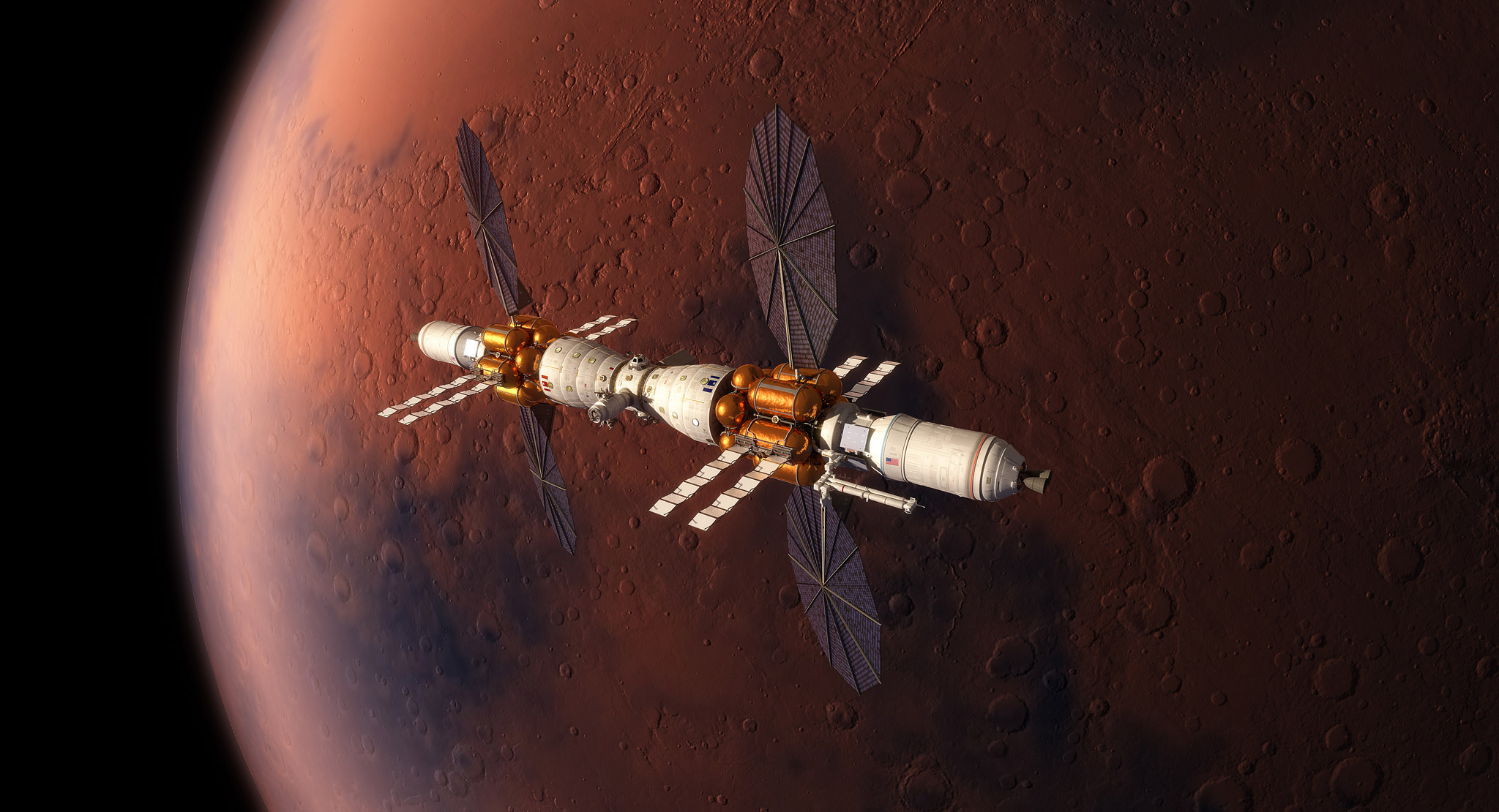


Cool pictures!
However, a permanent Moon base and tapping Lunar resources will come first and most likely, after we tap Lunar water and volatiles, we will also mine our Moon’s rich deposits of thorium and use that thorium to make U-233 on the Moon to power nuclear reactors and super high Isp Orion nuclear pulse spaceships that can enable us to fly large, powerful, and reusable spaceships on fast exploration missions and cargo and resource carrying trips across our Solar System.
Russia and America could fly long, high risk, super costly, and slow human missions to Mars, Ceres, or Pluto using low Isp, weak, and inefficient chemical rocket powered spaceships or we could use much more capable, safer, faster, and reusable Orion nuclear pulse spaceships powered by Lunar U-233 and having an Isp 13 times, or perhaps even well over a hundred times, higher than the best chemical rocket engine.
Everything powered by Lunar U-233 would be kept on or near the Moon or in deep space far from the Earth and thus a nuclear accident would not contaminate the Home Planet.
Note:
“Building a strategic capability for advancing and sustaining human space exploration in the vicinity of the Moon will require the best from NASA, interested international partners, and U.S. industry. As NASA continues formulating the deep space gateway concept, the agency signed a joint statement with the Russian Space Agency, Roscosmos, on Wednesday, Sept. 27 at the 68th International Astronautical Congress in Adelaide, Australia.”
And, “This joint statement reflects the common vision for human exploration that NASA and Roscosmos share. Both agencies, as well as other International Space Station partners, see the gateway as a strategic component of human space exploration architecture that warrants additional study. NASA has already engaged industry partners in gateway concept studies. Roscosmos and other space station partner agencies are preparing to do the same.”
And, “‘While the deep space gateway is still in concept formulation, NASA is pleased to see growing international interest in moving into cislunar space as the next step for advancing human space exploration,’ said Robert Lightfoot, NASA’s acting administrator at NASA Headquarters in Washington. ‘Statements such as this one signed with Roscosmos show the gateway concept as an enabler to the kind of exploration architecture that is affordable and sustainable.'”
From: ‘NASA, Roscosmos Sign Joint Statement on Researching, Exploring Deep Space’
By Cheryl Warner 9/27/2017
NASA Human Exploration and Operations Mission Directorate
At: https://www.nasa.gov/feature/nasa-roscosmos-sign-joint-statement-on-researching-exploring-deep-space
“The fission powered Orion could even achieve three to five percent the speed of light, though a more advanced design using fusion might achieve eight to ten percent the speed of light.”
And, “A ten-meter Orion ship could get a crew of eight men from Earth to Mars orbit and back in 150 days (chemical missions would require 300–450 days round trip at best) in a vehicle weighing just under 1,000 tons with a 100-ton payload. The SEOB, with a payload capability of 5,000 tons, was akin to the ‘Advanced Interplanetary Orion’ design developed later during Project Orion, which had a gross mass of 10,000 tons and could take 5,300 tons to the same Mars orbit.”
And, “Recently declassified internal budget documents show that, in 1962, the US Air Force had plans to build entire fleets of giant Orion spacecraft, and was prepared to commit almost 20 percent of its requested space budget from 1963 to 1967 to its realization.”
And, “It is one thing to hear Freeman Dyson, the eminent physicist and Project Orion veteran, say that the ‘end result [of Project Orion] was a rather firm technical basis for believing that vehicles of this type could be developed, tested, and flown. The technical findings of the project have not been seriously challenged by anybody. Its major troubles have been, from the beginning, political.’2 It is another to have that confirmed by Air Force internal memoranda.”
From: ‘Starfleet was closer than you think’
By Major Brent Ziarnick and Lt. Col. Peter Garretson 3/16/2015
At: http://www.thespacereview.com/article/2714/1
“Yes, Elon Musk still absolutely wants to go to Mars. But in a speech delivered Friday in Adelaide, Australia, the founder of SpaceX opened the door to sending humans to the Moon first. ‘It’s 2017, we should have a lunar base by now,’ he said, speaking just a couple of years shy of the 50th anniversary of the Apollo landings. ‘What the hell is going on?’
From: ‘Musk revises his Mars ambitions, and they seem a little bit more real’
By Eric Berger 9/29/2017
At: https://arstechnica.com/science/2017/09/musk-revises-his-mars-ambitions-and-they-seem-a-little-bit-more-real/?comments=1&post=34070637&mode=quote
Well, if Mr. Musk really wanted an answer and asked his good ‘political friend’ that question, former President Obama might ignorantly note, ‘We’ve already been there and a Moon Base really isn’t on my bucket list.”
Or if Mr. Musk wants to ask someone else for an explanation of why our American human return to the Moon was cancelled and who really benefited from that cancellation, he could perhaps look in a mirror.
Moving on and away from his odd and useless blame game:
“At an annual gathering of 4,000 global space experts in Adelaide, the ESA said the Moon was the ‘right place to be’ as humans expand economic activities beyond low-Earth orbit, even while Mars remained the ‘ultimate destination'”.
And, “Messina said the more immediate goal was to have a permanent presence on the Moon, even if it was just a robot, by the end of the next decade.”
And, “‘There are a series of missions planned to the moon over the next 10 years, and all these missions will create a movement, a momentum, and will create a wealth of data that will enable building the village,’ he added.”
From: ‘Moon village the first stop to Mars: ESA’ 9/28/2017
At: https://phys.org/news/2017-09-moon-village-mars-esa.html
What are the plans for artificial gravity?
None, it’s not essential and the opportunity costs of artificial gravity R&D would be better invested on other flight safety systems.
“it’s not essential and the opportunity costs of artificial gravity R&D would be better invested” – se jones
And your Mars Colonies Soon cult scientific and peer reviewed evidence of several dozen human experiments for this specious “not essential” fairyland claim is to be found precisely where?
Which scientist or group of scientists have demonstrated with human experiments and beyond a doubt that “artificial gravity” is “not essential” and won’t be needed for extended two-year stays or decades long residence in colonies on the Moon, Mars, and the thousands of other useful low gravity places across our Solar System?
Yep, with your Mars Colonies Soon cult pixie dust magical thinking and a deep lack of concern for maintaining the excellent health of space folks there is no need for “artificial gravity R&D” and no need for using heavy Galactic Cosmic Radiation shielding on the various super long and slow flights powered by the weak and inefficient chemical propulsion engines of an Interplanetary Mini BFR heading to Mars or Jupiter’s moons and wherever else it is supposed to go and set up solar panels to make rocket propellants.
The loving embrace of scientific igorance that is loudly and publicly promoted by the Mars Colonies Soon cult is both foolish and super risky.
The space ignorant Mars Colonies Soon folks may need to get rid of NASA and various other national space agencies around the world because NASA and most of the world’s space experts might not agree with an unending stream of such risk ignoring space nonsense.
Very Nice and all within 10 years…If we increase NASA funding by a factor of 10 taking the annual $20B funding to $200B because this architecture is in the $1T to $1.5T cost range.
Tracy the Troll –
“’Sending humans to Mars has always been a part of science fiction, but today we have the capability to make it a reality,’ said Lisa Callahan, vice president and general manager of Commercial Civil Space at Lockheed Martin.” From the above article.
Perhaps that comment isn’t quite accurate.
We had the technology, or most of it, to efficiently and cost effectively get to Mars long ago with large and reusable spaceships, but we just didn’t really want to use Orion nuclear pulse technology for fear of contaminating the Earth with radiation.
However, there was, and is, a known solution to avoiding that risk of radiation contamination of the Home Planet.
Base the Orion spaceships on, or in orbit around, the Moon.
Note:
“Dr. Brian Dunne, chief experimentalist for Project Orion”
“Dunne: Dyson and Taylor were primarily interested in exploring the planets, particularly Mars and the rings of Saturn. Dyson envisioned trips to the outer planets, very big expeditions with very, very big payloads. That was their immediate goal, and they would have liked to do it in their lifetimes.”
And, “Dunne: I long have felt that the proper place for Orion is on the moon. But the political and economic view of the project was directed to lifting payloads off the earth. This was, of course, before we went to the moon and before there were any big rockets for lifting, even by chemical means. The idea of setting up a lunar city was so far out, so much in the arena of fantasy, that people couldn’t take that and then add to it an Orion base. It was just too much for people to think about.”
From: ‘The Golden Age of Atomic Power in Space’ By Laurence B. Winn 1/1/2001
At: http://www.solutionsbylaurencewinn.com/Frontier_Theory/31-General%20Atomic.html
If or when we humans get serious about risk and cost reduced missions to Mars and the asteroids and the hundreds or thousands of dwarf planets out past Pluto, we will mine the rich deposits of Lunar thorium to make U-233 to power nuclear thermal rockets for landers, various types of fast and super efficient nuclear pulse powered Orion spaceships, and compact nuclear reactor power systems that can efficiently make lots of electricity for our spaceships and mining colonies across our Solar System.
Making and using the U-233 and everything else nuclear will be done on, or in orbit, around the Moon or in deep space and far away from the Earth’s magnetosphere and thus the risk of nuclear contamination of the Home Planet will not be a real issue.
“At its Marshall Space Flight Center, NASA is (in 2013) simulating nuclear thermal rocket fuels with the interim goal of developing a Nuclear Cryogenic Propulsion Stage in support of the Space Launch System. The project could see rocket stages twice as efficient as their chemical counterparts propelling crewed missions to the Moon, Mars and beyond.[11]”
From: “Nuclear thermal rocket” Wikipedia
At: https://en.wikipedia.org/wiki/Nuclear_thermal_rocket
“Orion is one of very few interstellar space drives that could theoretically be constructed with available technology, as discussed in a 1968 paper, Interstellar Transport by Freeman Dyson.”
And, “Efficient directional explosives maximized the momentum transfer, leading to specific impulses in the range of 6,000 seconds, or about thirteen times that of the Space Shuttle Main Engine. With refinements a theoretical maximum of 100,000 seconds (1 MN•s/kg) might be possible. Thrusts were in the millions of tons, allowing spacecraft larger than 8 × 106 tons to be built with 1958 materials.[3]”
From: ‘Nuclear pulse propulsion’ Wikipedia
At: https://en.wikipedia.org/wiki/Nuclear_pulse_propulsion
Powerful and super efficient nuclear pulse Orion spaceships based in Lunar orbit will also give us many real and useful opportunities to deflect or destroy large incoming NEOs.
Or we could continue to ignore those rich deposits of Lunar thorium, and the powerful nuclear pulse Orion spaceship enabled NEO defense capabilities that the Lunar thorium could enable, just like the once dominant dinosaurs, and our last anti-Moon President, did.
Very exciting times …
Check out the SpaceX version of getting to Mars at http://www.spacex.com/mars. While all the talk is getting back to the moon…LM and SpaceX are continuing to race to Mars! SpaceX announced that their entire rocket fleet of the F9, FH and D1,D2 will be replaced by the BFR Booster and BFR Payload/Crew Ship. The R&D will be funded by Satellite Launch. The BFR development has already been started with the Raptor engine and the LOX Tank development. Musk expects rollout in 5 years of the first BFR system with launches to Mars in 2022 and Crews in 2024. But wait there’s more…He plans on a global spaceline business to put 200 to 300 people anywhere in the world in less than 1 hour using the same BFR system. I am in shock! What say you?
Tracy the Troll –
Your “Very exciting times” comment is true.
But strangely enough the Rube Goldberg Falcon Heavy has not even flown yet and nonetheless Mr. Elon Musk has already decided to quit flying it and the Falcon 9. We Americans can kiss most of those many tax dollars and the endless NASA technical help that he received for building those rockets ‘goodbye’!
Bye-bye to the Falcon 1, 9, and Heavy jobs programs! New snake oil sales are needed soon!
“Musk intends to finance his $10 billion Mars endeavor by using a rocket that’s smaller than the one outlined last year. Fewer engines would be needed: 31 versus the originally envisioned 42. Its lift capability would be 150 tons, more than NASA’s old moon rocket, the Saturn V.”
“Musk said the same spaceship for moon and Mars trips — long and cylindrical with small shuttle-like wings — could fly to the space station. He said the mega-rocket could be used to establish a lunar settlement, with spaceships being refueled in Earth orbit versus creating a vital fuel depot at Mars.”
From: ‘SpaceX: Rocket for moon, Mars and NY-to-Shanghai in 39 mins’
By Marcia Dunn September 30, 2017
At: https://www.yahoo.com/news/travel-anywhere-under-hour-elon-musks-plan-093126583.html
Yikes! A Moon and Mars rocket with “wings”! Whatever happened to the old Mars Colonies Soon cult mantra that reusable spaceships using rocket propulsion landing meant you didn’t need “wings”?
Maybe the evolved SLS will also sometimes have some “wings”. A sometimes reused SLS core would be nifty!
Future evolved versions of the SLS might eventually have heavier LEO payload capabilities than the “150 tons” of the proposed SpaceX mini “mega-rocket”.
It seems like SpaceX has pumped former President Obama’s Uncle Sam sweet subsidy money well dry, and Mr. Musk is desperately trying to remain relevant in a world where Russia is planning to build a super heavy launcher with a LEO payload that may well exceed “150 tons”.
“The Russian ‘Lego’ approach to building heavy-lift rockets will also make it possible to fly lighter and heavier variants of the rocket. By attaching either two or six strap-on boosters to the core stage, the payload capacity can be reduced to around 70 tons or increased to 170–180 tons.”
From: ‘Russia’s evolving rocket plans’ Page 2 By Bart Hendrickx September 5, 2017
At: http://thespacereview.com/article/3321/2
And the Russians long ago built a reusable large spaceship with “wings” called the Buran.
Lots of serious space folks even want a permanent and resource tapping base on the Moon to help develop Cislunar Space!
Yep, “Very exciting times”!
It is quite apparent that using the Moon as a staging point for an eventual Mars mission is the logical approach.